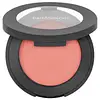What's inside
What's inside
 Key Ingredients
Key Ingredients

 Benefits
Benefits

 Concerns
Concerns

 Ingredients Side-by-side
Ingredients Side-by-side

Talc
AbrasiveMica
Cosmetic ColorantDimethicone
EmollientNylon-12
Zinc Stearate
Cosmetic ColorantSilica
AbrasiveMagnesium Myristate
Cetyl Dimethicone
EmollientSodium Hyaluronate
HumectantCaprylyl Glycol
EmollientLauroyl Lysine
Skin ConditioningHexylene Glycol
EmulsifyingPhenoxyethanol
PreservativeIron Oxides
CI 77891
Cosmetic ColorantCI 15850
Cosmetic ColorantCI 77007
Cosmetic ColorantCI 77742
Cosmetic ColorantCI 19140
Cosmetic ColorantDimethicone
EmollientSilica
AbrasiveEthylhexyl Isononanoate
EmollientDiisostearyl Malate
EmollientBoron Nitride
AbsorbentTrimethylsiloxysilicate
EmollientDimethicone Crosspolymer
Emulsion StabilisingLycopodium Clavatum Extract
Skin ConditioningImperata Cylindrica Root Extract
Skin ConditioningEthylhexylglycerin
Skin ConditioningBHT
AntioxidantNylon-12
Sodium Hyaluronate
HumectantGlycerin
HumectantMethicone
EmollientCalcium Aluminum Borosilicate
Tin Oxide
AbrasiveCalcium Sodium Borosilicate
Synthetic Fluorphlogopite
Phenoxyethanol
PreservativeIron Oxides
CI 77742
Cosmetic ColorantMica
Cosmetic ColorantCI 15850
Cosmetic ColorantCI 77891
Cosmetic ColorantDimethicone, Silica, Ethylhexyl Isononanoate, Diisostearyl Malate, Boron Nitride, Trimethylsiloxysilicate, Dimethicone Crosspolymer, Lycopodium Clavatum Extract, Imperata Cylindrica Root Extract, Ethylhexylglycerin, BHT, Nylon-12, Sodium Hyaluronate, Glycerin, Methicone, Calcium Aluminum Borosilicate, Tin Oxide, Calcium Sodium Borosilicate, Synthetic Fluorphlogopite, Phenoxyethanol, Iron Oxides, CI 77742, Mica, CI 15850, CI 77891
Ingredients Explained
These ingredients are found in both products.
Ingredients higher up in an ingredient list are typically present in a larger amount.
Ci 15850 is the pigment color red. It is an azo dye and created synthetically.
Azo dyes need to be thoroughly purified before use. This allows them to be more stable and longer-lasting.
This ingredient is common in foundations, lipsticks, and blushes. This color is described as brown/orangey red.
It has many secondary names such as Red 6 and Red 7. According to a manufacturer, Red 6 usually contains aluminum.
Learn more about CI 15850This ingredient is used to add a violet color to cosmetics.
It is created by reacting phosphoric acid, ammonium dihydrogen orthophosphate, and manganese dioxide.
Ci 77891 is a white pigment from Titanium dioxide. It is naturally found in minerals such as rutile and ilmenite.
It's main function is to add a white color to cosmetics. It can also be mixed with other colors to create different shades.
Ci 77891 is commonly found in sunscreens due to its ability to block UV rays.
Learn more about CI 77891Dimethicone is a type of synthetic silicone created from natural materials such as quartz.
What it does:
Dimethicone comes in different viscosities:
Depending on the viscosity, dimethicone has different properties.
Ingredients lists don't always show which type is used, so we recommend reaching out to the brand if you have questions about the viscosity.
This ingredient is unlikely to cause irritation because it does not get absorbed into skin. However, people with silicone allergies should be careful about using this ingredient.
Note: Dimethicone may contribute to pilling. This is because it is not oil or water soluble, so pilling may occur when layered with products. When mixed with heavy oils in a formula, the outcome is also quite greasy.
Learn more about DimethiconeMica is a naturally occurring mineral used to add shimmer and color in cosmetics. It can also help improve the texture of a product or give it an opaque, white/silver color.
Serecite is the name for very fine but ragged grains of mica.
This ingredient is often coated with metal oxides like titanium dioxide. Trace amounts of heavy metals may be found in mica, but these metals are not harmful in our personal products.
Mica has been used since prehistoric times throughout the world. Ancient Egyptian, Indian, Greek, Roman, Aztec, and Chinese civilizations have used mica.
Learn more about MicaNylon-12 is a polymer. It is derived from 12-aminododecanoic acid, an omega-amino fatty acid
According to a manufacturer, it is a talc substitute. Like talc, nylon-12 gives products a satin feel. The manufacturer also claims this ingredients does not block pores and has moderate oil absorption.
This ingredient may not be reef-safe.
Learn more about Nylon-12Phenoxyethanol is a preservative that has germicide, antimicrobial, and aromatic properties. Studies show that phenoxyethanol can prevent microbial growth. By itself, it has a scent that is similar to that of a rose.
It's often used in formulations along with Caprylyl Glycol to preserve the shelf life of products.
Silica, also known as silicon dioxide, is a naturally occurring mineral. It is used as a fine, spherical, and porous powder in cosmetics.
Though it has exfoliant properties, the function of silica varies depending on the product.
The unique structure of silica enhances the spreadability and adds smoothness, making it a great texture enhancer.
It is also used as an active carrier, emulsifier, and mattifier due to its ability to absorb excess oil.
In some products, tiny microneedles called spicules are made from silica or hydrolyzed sponge. When you rub them in, they lightly polish away dead skin layers and enhance the penetration of active ingredients.
Learn more about SilicaSodium Hyaluronate is hyaluronic acid's salt form. It is commonly derived from the sodium salt of hyaluronic acid.
Like hyaluronic acid, it is great at holding water and acts as a humectant. This makes it a great skin hydrating ingredient.
Sodium Hyaluronate is naturally occurring in our bodies and is mostly found in eye fluid and joints.
These are some other common types of Hyaluronic Acid:
Learn more about Sodium HyaluronateThis ingredient is a combination of red, black, and yellow iron oxide pigments. This combination of colors is usually found in foundation, because it results in a "skin" color.